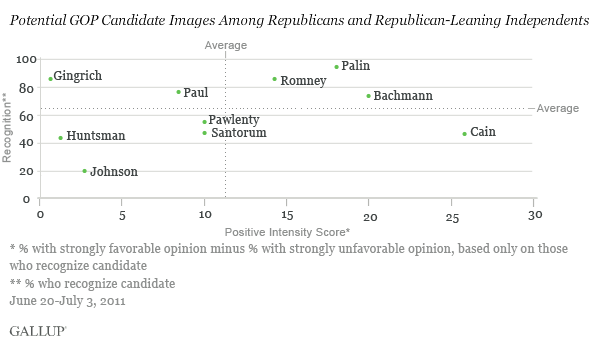PRINCETON, NJ -- Former Utah Gov. Jon Huntsman, who formally announced his presidential candidacy two weeks ago, has so far been unable to generate much positive intensity from Republicans nationwide. He is recognized by 42% of Republicans, and among those generates a Positive Intensity Score of 2, essentially tied with Newt Gingrich and Gary Johnson as the lowest of any Republican Gallup tracks.

Huntsman's name recognition among Republicans has risen 22 points from early this year, but at 42%, Huntsman remains among the least well-known candidates in Gallup's tracking, with a name identification exceeding only Johnson's. Huntsman is less well known than Herman Cain, Rick Santorum, or Tim Pawlenty, and is recognized by less than half as many Republicans as know Mitt Romney or Sarah Palin.
Just as importantly, 5% of Republicans who recognize Huntsman have a strongly favorable opinion of him, tied with Johnson for the lowest such percentage of any candidate measured. Three percent of Republicans who recognize Huntsman have a strongly unfavorable opinion of him.
More broadly, 55% of Republicans who recognize Huntsman have an overall favorable opinion, among the lowest of any Republican Gallup tracks, while 21% have an unfavorable opinion. That one in four Republicans who recognize Huntsman say they don't have an opinion about him either way underscores his overall weak image.
Michele Bachmann's Positive Intensity Score in this week's report has settled down to 20 from 24 last week, but this is still the second-highest such score of any Republican measured, behind only Herman Cain at 26. Palin, at 18, and Romney, at 14, trail Cain and Bachmann.
Bachmann's name recognition is now at 74%, up 22 percentage points from early March. Bachmann is now essentially as well-known as Ron Paul; these two sitting U.S. representatives trail only Romney, Gingrich, and Palin in terms of their recognition among Republicans.
There has been little change in the positioning of Pawlenty, Santorum, or Paul. Paul is the best known of these, while Santorum is the least well known. All three have nearly identical Positive Intensity Scores in the 9 to 10 range, roughly where they have been for weeks.
The image of former Speaker of the House Gingrich among Republicans nationwide is now the worst of any candidate tested. His Positive Intensity Score is 1, based on 11% strongly favorable and 10% strongly unfavorable opinions among Republicans who recognize him. Forty-one percent of Republicans who recognize Gingrich have either an unfavorable or a strongly unfavorable opinion, 15 points higher than the overall unfavorable opinions for Palin, who has the next-highest total.
Implications
Overall, two GOP presidential candidates continue to generate the most enthusiastic response from Republicans nationwide -- Cain and Bachmann. Both, however, trailed Romney when Republicans were last asked to name their current preference for the Republican nominee, based in part on Romney's higher name identification.
The Positive Intensity Score for unannounced candidate Palin is the third highest, also ahead of that for Romney. Romney's score has fluctuated somewhat in 2011; it reached a high of 20 earlier this year and was at 19 just three weeks ago, but is now down to his lowest since late May.
There are few signs of shifts or change among other candidates measured in Gallup tracking. Two former governors -- Huntsman and Pawlenty -- are often mentioned as potentially strong challengers to Romney, but neither is showing signs of unusually positive response from Republicans. Huntsman in particular is in an inauspicious position at this point, essentially tied with Gingrich and Johnson for the lowest Positive Intensity Score of any candidate measured.
Survey Methods
Results are based on telephone interviews conducted as part of Gallup Daily tracking June 20-July 3, 2011, with random samples of Republicans and Republican-leaning independents, aged 18 and older, living in all 50 U.S. states and the District of Columbia. Questions asking about the 10 potential candidates measured in this research were rotated among randomly selected samples of Republicans each night; over the 14-day period, each candidate was rated by a minimum of 1,500 Republicans and Republican-leaning independents.
For the overall ratings of each potential candidate among Republicans and Republican-leaning independents, including recognition scores, one can say with 95% confidence that the maximum margin of sampling error is ±3 percentage points. For the Positive Intensity Score for each candidate, the maximum margin of sampling error varies depending on the size of the group recognizing the candidate.
Interviews are conducted with respondents on landline telephones and cellular phones, with interviews conducted in Spanish for respondents who are primarily Spanish-speaking. Each sample includes a minimum quota of 400 cell phone respondents and 600 landline respondents per 1,000 national adults, with additional minimum quotas among landline respondents for gender within region. Landline telephone numbers are chosen at random among listed telephone numbers. Cell phone numbers are selected using random-digit-dial methods. Landline respondents are chosen at random within each household on the basis of which member had the most recent birthday.
Samples are weighted by gender, age, race, Hispanic ethnicity, education, region, adults in the household, and phone status (cell phone only/landline only/both, cell phone mostly, and having an unlisted landline number). Demographic weighting targets are based on the March 2010 Current Population Survey figures for the aged 18 and older non-institutionalized population living in U.S. telephone households. All reported margins of sampling error include the computed design effects for weighting and sample design.
In addition to sampling error, question wording and practical difficulties in conducting surveys can introduce error or bias into the findings of public opinion polls.
For more details on Gallup's polling methodology, visit www.gallup.com.
